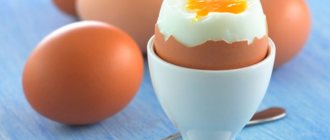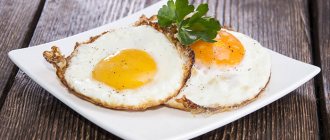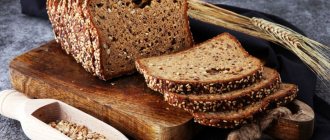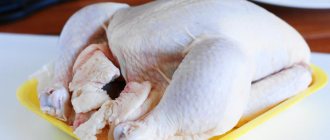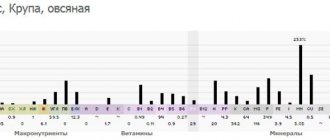Calorie content of fried eggs
- From 1 egg
The calculation is carried out with the addition of sunflower oil: 1 spoon.
1 egg (75 kcal) + butter (40 kcal) = 115 kcal.
- From 2 eggs
2 eggs (150 kcal) + butter (40 kcal) = 190 kcal.
- From 3 eggs
3 eggs (225 kcal) + butter (40 kcal) = 265 kcal.
- From 4 eggs
4 eggs (300 kcal) + butter (40 kcal) = 340 kcal.
Chemical composition and nutritional value
Everyone knows about the high cholesterol content in egg yolk, since this substance is contraindicated for people diagnosed with atherosclerosis. Therefore, until recently, they tried to exclude this product from the diet of some patients.
But in addition to harmful substances, eggs are rich in vitamins, macro- and microelements, including:
- vitamins A, B1, B2, B3, B4, B5, B6, B9, B12, D and D3, E, K, beta-carotene;
- minerals – K (potassium), Ca (calcium), Fe (iron), Mg (magnesium), P (phosphorus), Na (sodium), Zn (zinc), Cu (copper), Mn (manganese), Se ( selenium) and F (fluorine).
In addition, it is an irreplaceable source of animal protein, which is very well absorbed by the human body. From this product we can also get folic acid, biotin, choline, amino acids (methionine, leucine).
By consuming just one egg per day, you can get all of the listed valuable substances in a balanced combination. And if you eat several pieces a day without the yolk, you can reach your daily protein intake.
How many calories are in scrambled eggs with boiled sausage?
Contains boiled sausage (100 grams) + a spoonful of vegetable oil.
- From 1 egg
1 egg (75 kcal) + butter (40 kcal) + boiled sausage (250 kcal) = 365 kcal.
- From 2 eggs
2 eggs (150 kcal) + butter (40 kcal) + boiled sausage (250 kcal) = 440 kcal.
- From 3 eggs
3 eggs (150 kcal) + butter (40 kcal) + boiled sausage (250 kcal) = 515 kcal.
- From 4 eggs
4 eggs (150 kcal) + butter (40 kcal) + boiled sausage (250 kcal) = 590 kcal.
Daily consumption rate
According to research, 100 g of fried eggs contains protein and fat in an amount equal to 18% of the daily intake, and the content of some vitamins and minerals is more than 50%.
The table presents data on the quantity and share in the daily diet of all fat-soluble, water-soluble vitamins, micro- and macroelements contained in the product:
| Vitamins | Content | Share of daily value, % | Minerals | Content | Share of daily value, % |
| A | 219.0 mcg | 24,3 | Ca (calcium) | 62.0 mg | 6,2 |
| B1 | 0.066 mg | 3,7 | Fe (iron) | 1.9 mg | 18,9 |
| B2 | 0.44 mg | 38,1 | Mg (magnesium) | 13.0 mg | 3,3 |
| B3 | 0.1 mg | 0,5 | P (phosphorus) | 215.0 mg | 30,7 |
| B4 | 320 mg | 63,4 | K (potassium) | 152.0 mg | 3,2 |
| B5 | 1.7 mg | 33,2 | Na (sodium) | 207.0 mg | 15,9 |
| B6 | 0.2 mg | 14,2 | Zn (zinc) | 1.4 mg | 12,6 |
| B9 | 51.0 mcg | 13,0 | Cu (copper) | 0.1 mg | 8,7 |
| B12 | 1.0 mcg | 40,0 | Mn (manganese) | 0.05 mg | 1,3 |
| D | 2.2 mcg | 14,7 | Se (selenium) | 33.1 mcg | 60,2 |
| D3 | 2.2 mcg | 13,5 | F (fluorine) | 1.2 mcg | 0,06 |
| E | 1.3 mg | 9,0 | |||
| K | 5.6 mcg | 4,7 | |||
| beta carotene | 35.0 mcg | 0,7 |
Depending on the method of preparing an egg dish, the content of minerals and vitamins may vary, since some of them are destroyed during heat treatment.
Calorie content of scrambled eggs with tomatoes
Contains 1 tomato (100 grams) + a spoon of vegetable oil.
- From 1 egg
1 egg (75 kcal) + butter (40 kcal) + tomato (20 kcal) = 135 kcal.
- From 2 eggs
2 eggs (150 kcal) + butter (40 kcal) + tomato (20 kcal) = 210 kcal.
- From 3 eggs
3 eggs (225 kcal) + butter (40 kcal) + tomato (20 kcal) = 285 kcal.
- From 4 eggs
4 eggs (300 kcal) + butter (40 kcal) + tomato (20 kcal) = 360 kcal.
How to cook delicious scrambled eggs
Classic version
The calorie content of classic scrambled eggs fried in butter is 195 kilocalories.
Ingredients:
| Chicken eggs | 2 pcs. |
| Butter | 35 g |
| Salt | taste |
Cooking sequence:
- We take two chicken eggs out of the refrigerator and leave to warm to room temperature.
- Then wash them and place them in a deep container. We do this carefully so as not to pierce the yolk.
- Place a frying pan on the stove and add 35 grams of butter.
- Once the butter has melted, spread it over the entire surface of the pan.
- Place the eggs in a frying pan, add salt and cover with a lid. Fry for three minutes.
- Place on a plate and serve with bread.
With tomatoes and onions
The calorie content of scrambled eggs with onions and tomatoes is 209 kilocalories per 100 grams of product.
Ingredients:
| Onion | 1 PC. |
| Tomato | 1-2 pcs. |
| Chicken eggs | 3-4 pcs. |
| Vegetable oil | how much is needed for frying |
| Salt | taste |
Cooking sequence:
- Peel and cut one onion into half rings.
- Wash and cut 1-2 tomatoes into large cubes.
- Place a non-stick frying pan on the stove and pour the required amount of vegetable oil onto it.
- When the oil is hot, add the chopped onions and tomatoes. Fry for 2-3 minutes.
- Wash 3-4 chicken eggs and break them into a separate deep plate.
- After the vegetables are fried, add the eggs to the frying pan and mix all the ingredients.
- Add a little salt and stir the scrambled eggs until cooked.
Sausage
The calorie content of scrambled eggs from two eggs with sausage is 252 kilocalories per 100 grams of product.
Ingredients:
| Smoked sausage | 50 g |
| Chicken eggs | 2 pcs. |
| Fresh parsley | 20 g |
| Butter | 35 g |
| Salt | taste |
Cooking sequence:
- Cut 50 grams of smoked sausage into slices.
- Chop 20 grams of parsley.
- Place a non-stick frying pan on the stove and put 35 grams of butter on it.
- When the butter has melted, put the chopped sausage in a frying pan and fry each piece thoroughly.
- Wash two eggs and break them into a separate plate. This is done so that the shells do not fall into the frying pan.
- Pour the eggs into the frying pan, add salt to taste and cover with a lid.
- Fry the scrambled eggs for three to four minutes, transfer to a plate and serve with chopped parsley.
How many calories are in scrambled eggs with sausage?
Ingredients: 1 sausage (60 grams) + a spoon of vegetable oil.
- From 1 egg + 1 sausage
1 egg (75 kcal) + butter (40 kcal) + sausage (260 kcal) = 375 kcal.
- From 2 eggs + 2 sausages
Ingredients: 2 sausages (120 grams) + a spoonful of vegetable oil.
2 eggs (150 kcal) + butter (40 kcal) + 2 sausages (520 kcal) = 710 kcal.
- From 3 eggs + 3 sausages
Ingredients: 3 sausages (180 grams) + a spoonful of vegetable oil.
3 eggs (225 kcal) + butter (40 kcal) + 3 sausages (780 kcal) = 1045 kcal.
Directions
Scrambled eggs with vegetables
IngredientsDirections
Table 1
| Products | Weight | Squirrels | Fats | Carbohydrates |
| Olive oil | 20 gr | 0 | 19.96 | 0 |
| Bulb onions | 80 gr | 1.12 | 0.16 | 6.56 |
| Porcini | 50 gr | 1.85 | 0.85 | 0.55 |
| Salt | 10 g | 0 | 0 | 0 |
| Sweet red pepper | 175 gr | 2.28 | 0.18 | 9.28 |
| Jalapeno pepper | 45 gr | 0.41 | 0.18 | 1.67 |
| Cumin, seeds | 5 g | 0.99 | 0.73 | 0.6 |
| Paprika, ground sweet pepper | 3 g | 0.42 | 0.39 | 0.57 |
| Ground turmeric | 3 g | 0.29 | 0.1 | 1.33 |
| Black pepper | 2.5 g | 0.26 | 0.08 | 0.97 |
| cayenne pepper | 2 g | 0.01 | 0 | 0.2 |
| Tomato (tomato), ground | 800 gr | 8.8 | 1.6 | 30.4 |
| Water | 230 gr | 0 | 0 | 0 |
| Chicken egg | 360 gr | 45.72 | 41.4 | 2.52 |
| Chees Feta | 30 gr | 4.26 | 6.45 | 1.16 |
| Parsley (greens) | 16 g | 0.59 | 0.06 | 1.22 |
| Exit | 1200 | 67 | 72.14 | 57.03 |
Everything that connects a person and a scrambled egg
It is quite common for people to eat eggs or simple scrambled eggs for breakfast. And this happens for a reason. It's a matter of several things. First, you should point out that in the morning a person wants to stay in his bed as long as possible, therefore, he does not have much time to prepare his breakfast.
Scrambled eggs are prepared so quickly and easily that God himself ordered them to be cooked in the morning!
It has a fairly pleasant taste, and this dish is also very filling. So, after eating just one or two eggs, you will not experience an overwhelming feeling of hunger until the lunchtime meal.
Egg mechanism
Here is the mechanism. An egg contains a white and a yolk, and we have long known that both of these substances are extremely important for our body. At the same time, protein is very well absorbed by our body, which only benefits the body. The yolk contains a very large number of different polyunsaturated acids, which our body so needs. So eggs provide us with the necessary proteins that our body cannot produce on its own.
Eggs are considered one of the most environmentally friendly products; they contain many antioxidants and microelements, and they are also the most natural. However, now it’s worth focusing your attention on fried eggs - how many calories do they contain? This information will be especially interesting for those who cannot imagine their morning without a good scrambled egg.
Meanwhile, eggs have quite a high calorie content
More precisely, many calories are contained in the yolk - for one hundred grams of egg you can count on 232 (two hundred thirty-two) calories.
But you can reduce the calorie content of a fried egg much more significantly if you cook it in a non-stick frying pan without using fat or oil.
No matter what, calories from eggs only benefit a person, because they are easily absorbed by the body and carry with them a huge amount of useful microelements and substances.
By eating eggs you will not find extra centimeters on your body, but will only improve the internal condition of your body.
Nutritionists are of the opinion
That this product is very useful for brain activity, promoting the development of intelligence.
In addition, eggs are perfectly absorbed by the body. This is explained by the fact that as soon as the egg falls into the stomach, it produces a special substance called angiotensin. This substance has a beneficial effect on normalizing blood pressure and blood vessels.
By the way, for this purpose the eggs should be cooked not boiled, but fried.
You need to know when to stop!
But despite such great benefits from eating eggs, you should know when to stop. You need to eat eggs in the prescribed amount.
In addition, remember that eggs are a fairly strong allergen, so you should not give them to your child before two years of age.
If you have liver problems or allergic reactions to certain foods, then you should limit or even avoid this product.
What are the benefits of scrambled eggs?
Scrambled eggs are a fairly simple dish made from a minimal amount of ingredients, but despite this, it can have a positive effect on our body.
- If you regularly eat this dish, then vitamin E, which is in the composition, can increase the elasticity of blood vessels and contribute to the speedy healing of cuts, wounds and scratches.
- Thanks to vitamin A, eating scrambled eggs helps increase the elasticity of the skin, normalizes oxidative processes, and improves vision.
- If you add milk to a dish, it will help the body strengthen bones and bone tissue.
- Due to the presence of vitamin B, scrambled eggs can normalize the functioning of the nervous system, strengthen hair and enhance its growth.
- This dish also normalizes the level of vitamin D in the body. In addition, this element is not destroyed during heat treatment.
- This culinary product is also often used in various dietary programs. This happens because scrambled eggs contain a lot of healthy fatty acids. It is these substances that help you lose weight faster, and can also be an excellent means of preventing cancer.
- Egg whites are very useful for those who are actively involved in sports. And unlike meat protein, egg protein is digested much faster.
- In addition, scrambled eggs contain methionine and leucine, which are simply necessary for children in adolescence. They help the child’s body form correctly and support immunity. These amino acids also perfectly remove toxins from the liver and are used in the treatment of depression.
| Vitamins | Chemical name | Content per 100 grams | Percentage of daily requirement |
| Vitamin A | retinol equivalent | 241 mcg | 24% |
| Vitamin B1 | thiamine | 0.09 mg | 6% |
| Vitamin B2 | riboflavin | 0.54 mg | 23% |
| Vitamin C | ascorbic acid | 0 mg | 0% |
| Vitamin E | tocopherol | 3.6 mg | 34% |
| Vitamin B3 (PP) | niacin | 3.8 mg | 19% |
Calculation of calorie content of a recipe per 1200 grams
The calculation of the calorie content of 1200 grams of the recipe is based on the summarized indicators of BZhUK (abbreviation: proteins-fats-carbohydrates-acids) of the ingredients from table (1) involved in the preparation. The data was taken from the database of the “products” section of the website and brought into line with the final yield of the dish (net).
Our example involves proteins - 67 grams, fats - 72.14 grams and carbohydrates - 57.03 grams, contained in 1200 grams of the recipe. Next we perform the calculation:
Energy value of 1200 grams of recipe = 67 (proteins)*4 + 72.14 (fat)*9 + 57.03 (carbohydrates)*4 = 268 + 649.26 + 228.12 = 1145.4 kcal



